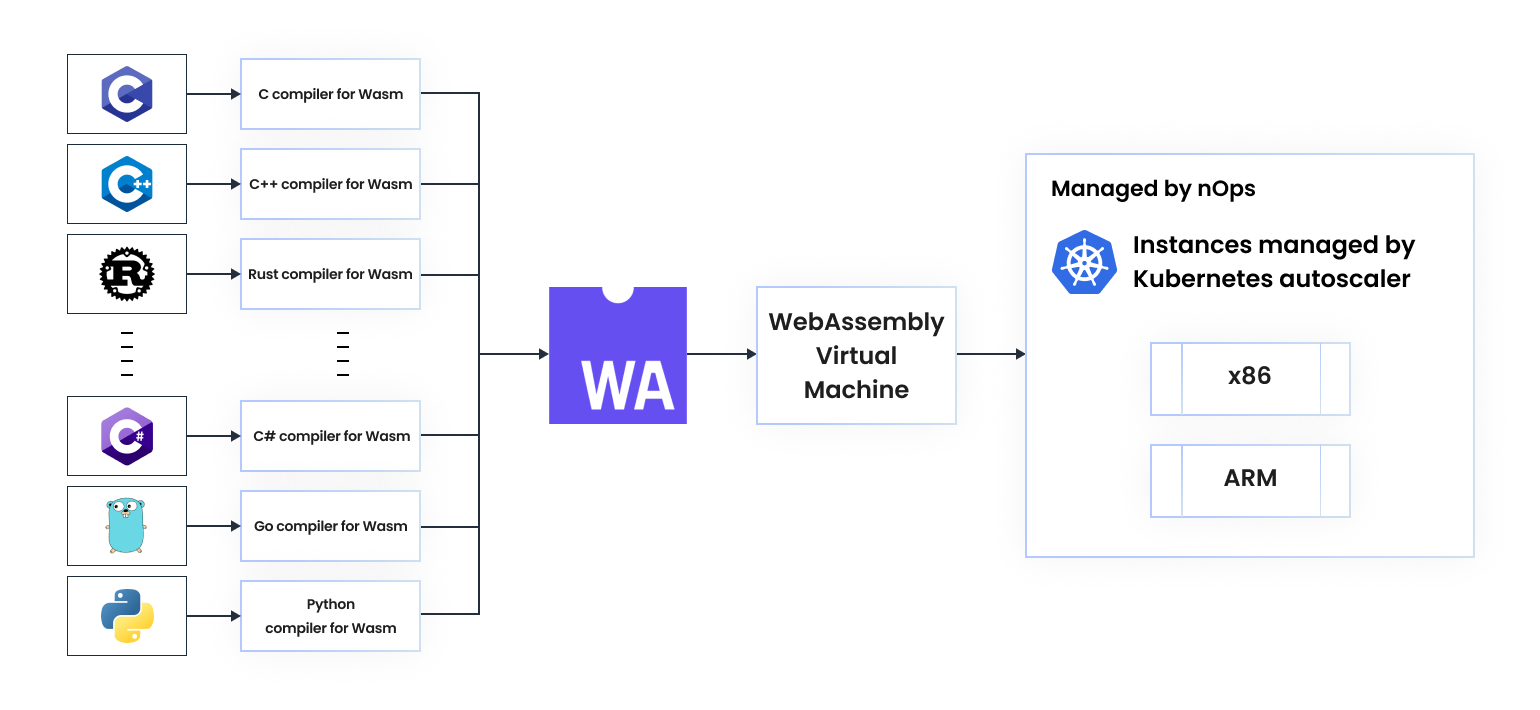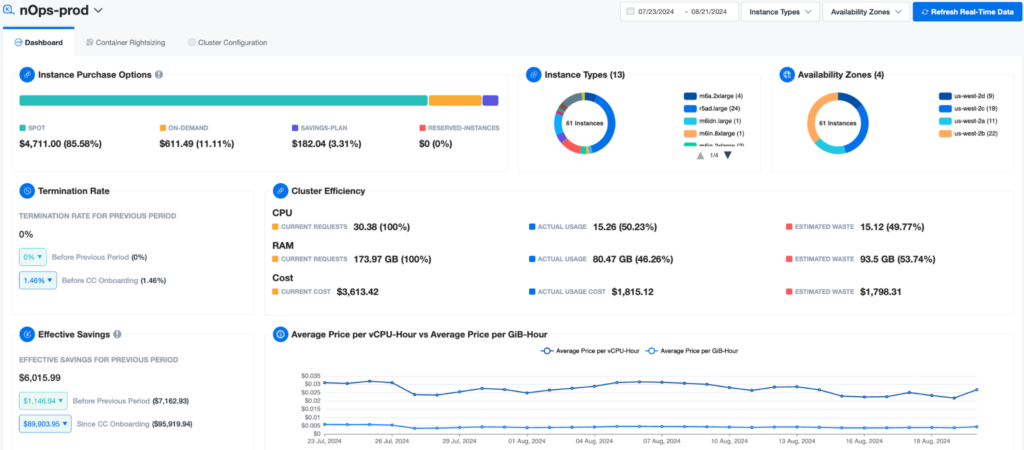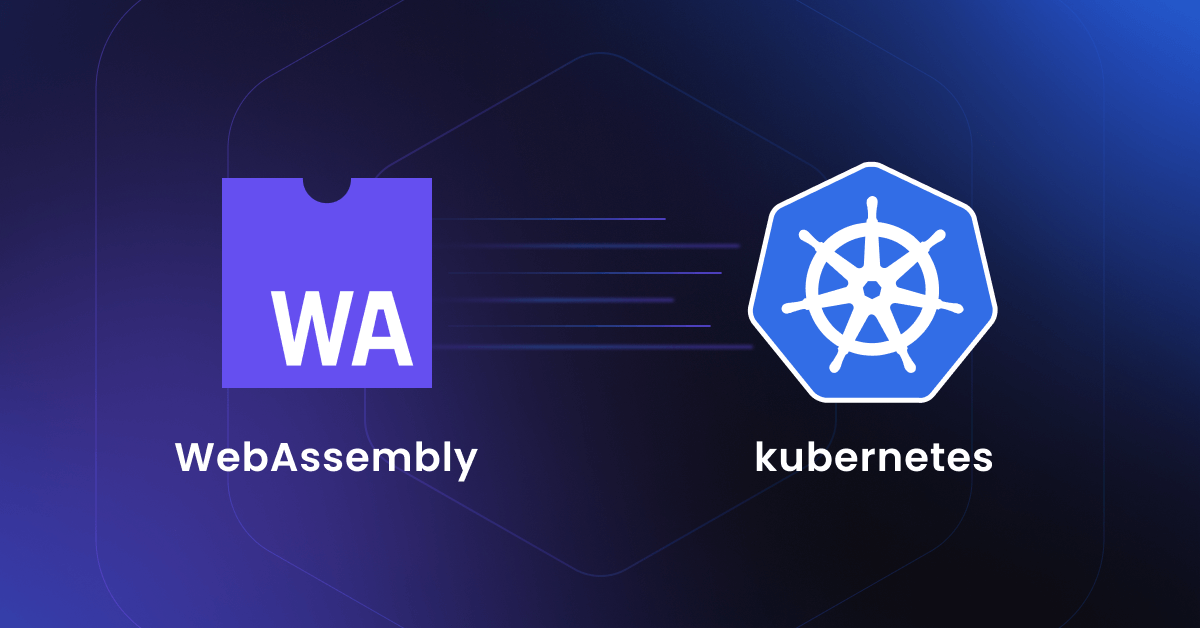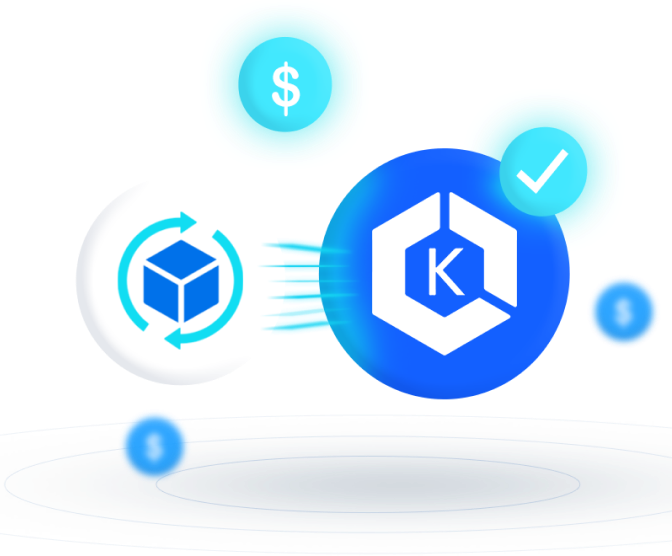
Originally designed for the browser, WebAssembly (Wasm) has quickly gained popularity for server-side applications due to its lightweight, fast, and secure nature. When combined with Kubernetes, the de facto standard for container orchestration, WebAssembly unlocks a new frontier for cloud-native applications.
In this article, we’ll dive into the practical aspects of running Wasm workloads on Kubernetes, with real world applications, example scenarios, and relevant tooling.
What is WebAssembly?

Compared to traditional containers, Wasm modules offer:
- Speed: Wasm apps run nearly as fast as natively coded apps
- Faster startup: Wasm modules typically start in milliseconds, which is ideal for workloads requiring near-instant startup times, such as serverless functions.
- Cost-effectiveness: Wasm modules consume significantly fewer CPU and memory resources than traditional container images, making them suitable for edge computing and resource-constrained environments.
- Security: Wasm modules run in a secure, isolated sandbox environment, minimizing the attack surface compared to traditional containers.
Why Wasm + Kubernetes
Deploying WebAssembly modules on Kubernetes allows you to leverage Kubernetes’ mature ecosystem for managing applications at scale. Kubernetes offers advanced features like automated deployment strategies, robust scheduling, and self-healing capabilities that aren’t readily available in other environments. By running Wasm workloads on Kubernetes, you can unify your operational workflows, managing both containerized and Wasm applications through the same platform.
This integration takes advantage of Kubernetes’ extensive tooling for networking, storage, monitoring, and logging. Compared to other deployment methods, Kubernetes provides a well-established infrastructure that improves the reliability, manageability, and observability of your Wasm applications.
One key component enabling this is RuntimeClass, a Kubernetes object that allows clusters to support multiple container runtimes. For example, some nodes might run traditional containers using runc, while others might run Wasm workloads using WasmEdge or crun.
Running WebAssembly Workloads on Kubernetes
Preparation: Setting Up Wasm-Enabled Kubernetes Nodes
To run Wasm workloads, the worker nodes must be bootstrapped with a WebAssembly runtime such as WasmEdge or Wasmtime. Additionally, tools like the Kwasm Operator can automate the process of installing these runtimes across Kubernetes nodes, removing the need for manual setup.
Here’s a quick overview of the steps involved:
- Install the WebAssembly runtime (e.g., WasmEdge or Wasmtime) on your Kubernetes nodes.
- Use the RuntimeClass object in Kubernetes to map Wasm-enabled nodes.
- Automate node configuration with tools like Kwasm Operator to streamline Wasm runtime installation.
By using a RuntimeClass object, you can schedule Wasm workloads specifically to nodes with Wasm runtimes, ensuring your WebAssembly modules run efficiently and securely.
Example 1: Deploying a Simple Wasm Application on Kubernetes
Deploying a Wasm application on Kubernetes involves configuring a RuntimeClass to manage Wasm workloads and ensuring worker nodes have Wasm runtime support.
Here’s how you can deploy a Wasm application using the crun runtime:
- Create a Kubernetes cluster with
kindor any other Kubernetes deployment tool. - Install the Wasm-compatible runtime (e.g., WasmEdge or crun) on the nodes.
Modify the containerd configuration file to point to the Wasm runtime:
[plugins."io.containerd.grpc.v1.cri".containerd.runtimes.crun]
runtime_type = "io.containerd.runc.v2"
pod_annotations = ["module.wasm.image/variant"]
3. Deploy the Wasm application inside a pod:
3.apiVersion: v1
kind: Pod
metadata:
name: wasm-demo-app
annotations:
module.wasm.image/variant: compat
spec:
runtimeClassName: crun
containers:
- name: wasm-demo-app
image: docker.io/cr7258/wasm-demo-app:v1
4. By adding a RuntimeClassName, you can ensure that the pod is scheduled on a node with Wasm runtime support. This setup allows Wasm applications to run in tandem with traditional Linux containers.
Example 2: Sidecar Pattern with Wasm and Linux Containers
One of the most powerful use cases for Wasm on Kubernetes is the sidecar pattern, where a Wasm module runs alongside a traditional Linux container. This can be especially useful for serverless applications or security-sensitive workloads.
To implement this pattern:
- Create a pod with both a Wasm container and a Linux container.
- Use the
module.wasm.image/variant: compat-smartannotation to enable Wasm workloads to run alongside Linux-based containers in the same pod.
This approach offers a practical way to combine the strengths of both container types in a single Kubernetes environment.
Tooling and Ecosystem
Wasm-Compatible Container Runtimes
Wasm container runtimes are Kubernetes CRI implementations that execute WebAssembly modules as containers within pods. They allow Kubernetes to schedule and manage Wasm workloads natively.

Tool/Project | Description |
A lightweight and fast OCI-compliant container runtime written in C. crun includes native support for running Wasm modules, making it efficient for clusters handling both traditional containers and Wasm workloads. | |
The standard container runtime for Kubernetes extended with the runwasi shim to support Wasm modules. This allows Kubernetes to schedule Wasm workloads alongside traditional containers seamlessly. | |
A sandboxed container runtime that supports multiple sandboxes, including Wasm. Kuasar offers enhanced security and isolation, providing a unified runtime environment for diverse applications. |
Wasm Runtimes and Engines
Wasm runtimes and engines are execution environments that run WebAssembly modules by compiling or interpreting wasm bytecode into native machine code.
A high-performance, lightweight Wasm runtime optimized for cloud-native applications. Supports the WebAssembly System Interface (WASI) and is ideal for serverless functions, microservices, and embedded applications. | |
Developed by the Bytecode Alliance, Wasmtime is a standalone runtime designed for safety and speed. Suitable for running Wasm modules in various environments, including Kubernetes clusters. | |
Wasm-micro-runtime (WAMR) | An extremely lightweight runtime designed for embedded and resource-constrained devices. WAMR supports multiple execution modes and is ideal for IoT and edge computing scenarios. |
Kubernetes integrations
Kubernetes integrations are tools that enable clusters to natively run and manage WebAssembly workloads alongside traditional containers.
A Kubernetes Kubelet implementation that allows scheduling and running Wasm modules as Kubernetes pods. Enables clusters to manage Wasm workloads natively. | |
A Kubernetes operator that simplifies the deployment and management of Wasm workloads on clusters. Automates the installation of Wasm runtimes on nodes and manages the lifecycle of Wasm applications. |
Development Frameworks and Tools
Development frameworks and tools provide environments and utilities for building, deploying, and running WebAssembly applications efficiently.
An open-source framework for building and running cloud applications with WebAssembly. Provides a developer-friendly environment for creating serverless applications using Wasm modules. | |
WAGI (WebAssembly Gateway Interface) | A lightweight application server that runs Wasm modules as HTTP handlers. Allows developers to write web applications in any language that compiles to Wasm, facilitating the creation of microservices and APIs. |
A distributed application runtime leveraging Wasm for building secure, portable, and scalable applications. Abstracts away underlying infrastructure complexities, enabling focus on business logic. |
Edge Computing and IoT Platforms

Edge computing and IoT platforms leverage WebAssembly to execute lightweight and secure applications on edge devices and resource-constrained environments.
An open-source project for discovering and monitoring leaf devices at the edge using Kubernetes. Utilizes Wasm to run lightweight agents on edge devices, simplifying resource management in distributed environments. | |
A cloud platform offering a fully managed environment for deploying Wasm applications across cloud and edge infrastructures. Built upon wasmCloud for seamless scalability and portability of Wasm workloads. |
Networking and Service Mesh Extensions
Networking and service mesh extensions use WebAssembly modules to extend network proxies and meshes with custom functionality without modifying the core systems.
An SDK and ABI standard for extending network proxies like Envoy with Wasm modules. Enables custom filtering, routing, and observability features without modifying the proxy codebase, allowing dynamic, high-performance extensions. | |
Envoy proxy supports Wasm filters, allowing developers to write custom filters in languages like Rust and Go. Facilitates the development of advanced networking features and policies within a service mesh. |
Security and Sandbox Enhancements
Security and sandbox enhancements offer additional isolation and protection mechanisms for WebAssembly workloads.
A framework for running applications in Trusted Execution Environments (TEEs) using Wasm. Focuses on confidential computing, providing hardware-based security guarantees for Wasm workloads on untrusted infrastructure. | |
Tools and libraries that enhance the security of Wasm modules by providing additional isolation and sandboxing capabilities. Essential for multi-tenant environments where security is a top priority. |
Observability and Monitoring tools
Business Contexts+ makes it easy to understand and allocate your AWS costs down to the container level. It also adds enhanced functionality to simplify the AWS cost reporting process for DevOps, Engineering, FinOps, and Finance teams.
With custom reports and dashboards built by FinOps experts, role-based access control, and 40+ filters and views, Business Contexts+ makes it easy to get the cost insights your organization needs to better understand and optimize your AWS spend, particularly in complex containerized Kubernetes environments. | |
Wasm runtimes and applications can expose metrics in Prometheus format, allowing integration with existing monitoring systems for performance tracking and alerting. | |
Visualization tools like Grafana can create dashboards to monitor the performance and health of Wasm workloads within Kubernetes clusters, enhancing observability. |
Key Use Cases for WebAssembly on Kubernetes
WebAssembly’s unique characteristics make it ideal for several cloud-native use cases:
- Serverless Applications: Wasm’s fast startup and low resource consumption make it perfect for serverless workloads that require rapid scaling and cost efficiency.
- Edge Computing: Wasm’s portability and small size enable applications to run on edge devices with limited resources.
- Multi-Tenant Environments: Wasm’s strong sandboxing and security model make it well-suited for environments where multiple tenants share infrastructure.
WebAssembly is becoming increasingly popular, and its role in cloud-native ecosystems is only poised to grow. Emerging tools such as Kuasar (a sandboxing runtime that supports Wasm) and hosted platforms like Cosmonic and Fermyon Cloud are creating new opportunities for Wasm adoption. Additionally, Wasm is becoming an ideal execution engine for decentralized platforms, including blockchain-based smart contract networks.
A Complete Kubernetes Solution for Visibility, Management & Optimization
As teams increasingly adopt Kubernetes, they face challenges in configuring, monitoring and optimizing clusters within complex containerized environments. Most teams manage these complexities with a combination of manual monitoring, third-party tools, and basic metrics provided by native Kubernetes dashboards — requiring them to switch between different tools and analyze data from multiple sources.
With nOps, comprehensive Kubernetes monitoring and optimization capabilities unified into one platform including:
- Critical metrics for pricing optimization, utilization rates, waste optimization down to the pod, node or container level
- Total visibility into hidden fees like extended support, control plane charges, ipv4, data transfer, etc.
- Actionable insights on how to tune your cluster so you can take action on day 1.

The nOps all-in-one suite designed to transform how you interact with your Kubernetes environment to optimize cluster performance and costs. Key features include:
- Container Cost Allocation: nOps processes massive amounts of your data to automatically unify and allocate your Kubernetes costs in the context of all your other cloud spending.
- Container Insights & Rightsizing. View your cost breakdown, number of clusters, and the utilization of your containers to quickly assess the scale of your clusters, where costs are coming from, and where the waste is.
- Autoscaling Optimization: nOps continually reconfigures your preferred autoscaler (Cluster Autoscaler or Karpenter) to keep your workloads optimized at all times for minimal engineering effort.
- Spot Savings: Automatically run your workloads on the optimal blend of On-Demand, Savings Plans and Spot instances, with automated instance selection & real-time instance reconsideration.
nOps was recently ranked #1 with five stars in G2’s cloud cost management category, and we optimize $1.5+ billion in cloud spend for our customers.
Join our customers using nOps to understand your cloud costs and leverage automation with complete confidence by booking a demo with one of our AWS experts.
.png?width=1920&height=1080&name=Landscape%20(4).png)









